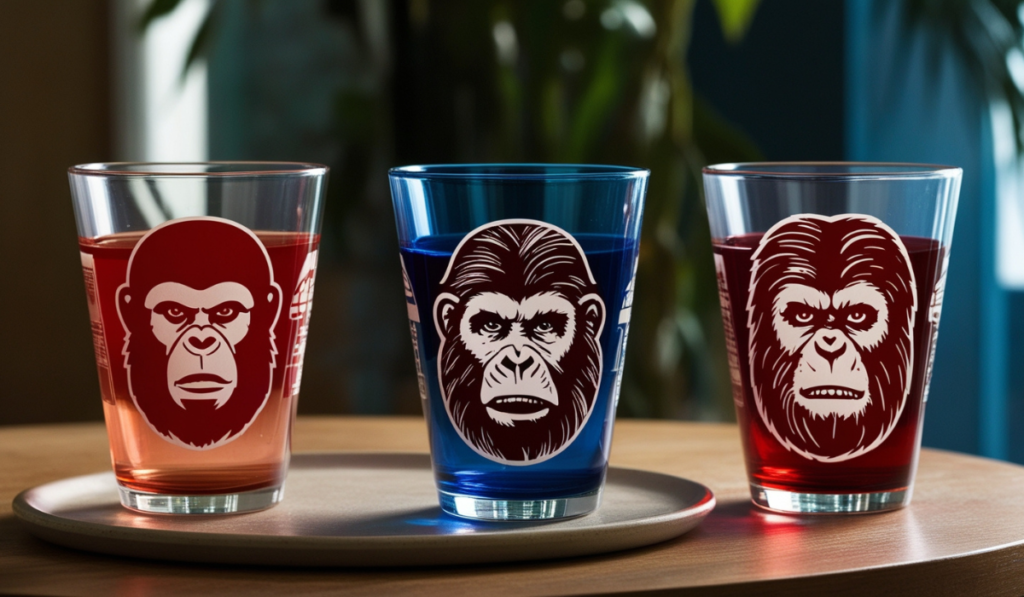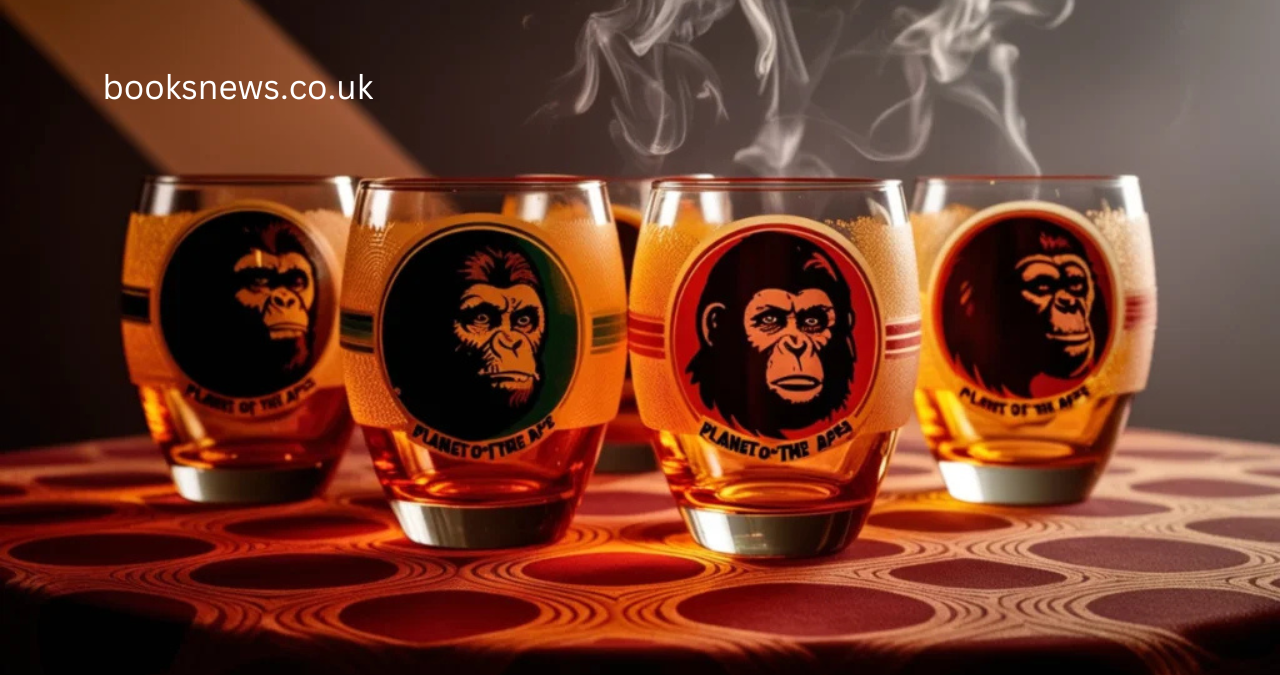Introduction
In the 1970s, the “Planet of the Apes” films not only captivated audiences with their thought-provoking narratives and groundbreaking makeup effects but also launched a merchandising frenzy that left a lasting imprint on pop culture. Among the myriad of merchandise, the Planet of the Apes drinking glasses from the 1970s emerged as a nostalgic emblem, cherished by collectors and fans alike. These glasses not only served as a functional household item but also as a mini-canvas showcasing the rich artwork and character images from the iconic film series.
Historical Context of the 1970s Planet of the Apes Merchandise
The 1970s marked a significant era where film merchandising began to burgeon, particularly with science fiction leading the charge. “Planet of the Apes,” originally released in 1968, spawned sequels that continued well into the 1970s, each adding layers to its complex story of dystopia and reversal of societal roles between humans and apes. This period witnessed the rise of movie-themed products, which allowed fans to extend their experience beyond the cinema. Planet of the Apes drinking glasses were among these products, capturing iconic scenes and characters such as Cornelius, Zira, and the formidable General Ursus.
As collectibles, these glasses serve as a window into the marketing and consumer trends of the era. They were often released as part of promotional campaigns in conjunction with fast-food chains or sold in stores, making them widely accessible to the public. This widespread distribution helped solidify the film’s presence in American households and contributed to the ongoing fan engagement that the series enjoys to this day.
Exploring the 1970s Planet of the Apes Drinking Glasses

Design and Artwork
The artwork on these glasses typically features vibrant, action-packed scenes from the movies, rendered in bold colors that have stood the test of time. Each glass often portrays a different scene or character, making them highly appealing to collectors who wish to complete a series. The detail in the artwork not only reflects the aesthetic of the era but also the significance of each character’s role in the film’s narrative.
Production and Materials
Manufactured primarily from thick, durable glass, these collectibles were built to last. The production quality of the 1970s glasses usually surpasses that of many modern equivalents, which often utilize cheaper materials and less durable printing techniques. Collectors appreciate these vintage pieces not only for their aesthetic appeal but also for their craftsmanship.
Collectibility and Value
The value of Planet of the Apes drinking glasses can vary significantly based on condition, rarity, and demand. Glasses that were part of limited runs or promotional events tend to command higher prices. The market for vintage film merchandise has seen a steady increase, with enthusiasts willing to pay premium prices for items in mint condition. Collectors often look for glasses that still have their original color and clarity, free from chips and fading, which are indicative of well-maintained pieces.
Collecting 1970s Planet of the Apes Drinking Glasses
Starting a Collection
For newcomers interested in collecting these glasses, it’s essential to educate oneself on the distinguishing features of authentic pieces. Engaging with online forums, attending collectible shows, and visiting antique shops can provide insights and opportunities to see different pieces firsthand, which is invaluable for building a discerning eye.
Maintaining the Collection
Maintaining the quality of these glasses involves proper cleaning and storage. Harsh detergents can strip the artwork off the glasses, so gentle cleaning with mild soap and water is recommended. Storing them out of direct sunlight and in a stable temperature environment will also help preserve the vibrant colors and delicate prints.
The Legacy of Planet of the Apes Merchandise
The legacy of Planet of the Apes merchandise like these drinking glasses lies in their ability to bridge generations of fans. They not only evoke nostalgia but also highlight how ahead of its time the film series was, both in terms of its narrative and its marketing strategies. These glasses are a testament to the lasting impact of the franchise and continue to be a valuable piece of memorabilia for collectors and enthusiasts.
Conclusion
The 1970s Planet of the Apes drinking glasses are more than just vessels for beverages; they are artifacts of film history and memorabilia culture. Their enduring appeal is a testament to the ingenuity of vintage marketing and the timeless allure of the franchise. As collectors continue to hunt for these prized pieces, the glasses not only serve as a nostalgic reminder of the past but also as an investment in the legacy of cinematic history.
FAQs
What are some identifying features of authentic 1970s Planet of the Apes drinking glasses?
Authentic 1970s Planet of the Apes drinking glasses typically feature vibrant, screen-printed artwork depicting characters and scenes from the movies. These glasses often have a thick, sturdy build, characteristic of glassware produced in that era. Look for bright, saturated colors and clear, sharp images. The glasses may also have markings or logos from the manufacturer at the bottom, which can help verify their authenticity and production period.
How can I verify the authenticity of a 1970s Planet of the Apes drinking glass?
Verifying the authenticity involves checking for specific production marks, such as manufacturer stamps on the glass bottom or specific print details known to be part of the original issues. Consulting with experienced collectors or referencing collector guides and websites dedicated to Planet of the Apes memorabilia can also provide insights and comparisons. Additionally, purchasing from reputable dealers or established auction sites with a provenance record can increase the likelihood of obtaining an authentic piece.
What is the average value of a 1970s Planet of the Apes drinking glass today?
The value can range significantly based on the condition, rarity, and specific print or series of the glass. Generally, prices can range from $10 to $50 for common pieces, but rarer items or glasses in pristine condition with original promotional materials can fetch higher prices, sometimes exceeding $100 or more. Market values fluctuate, so keeping an eye on recent auction sales and collector sites is advisable for the most current pricing.
Are there any specific care instructions for preserving the artwork on these vintage glasses?
To preserve the artwork on these glasses, it is crucial to avoid abrasive cleaning tools and harsh chemicals. Wash them by hand using mild soap and lukewarm water. Do not use dishwashers as the intense heat and strong detergents can degrade the print. For storage, keep the glasses away from direct sunlight, which can fade the colors over time, and store them in a stable, temperature-controlled environment to prevent stress cracks.
Where is the best place to purchase these collectible glasses?
The best places to find these collectible glasses include online auction sites like eBay, specialty collectibles websites, antique shops, and estate sales. Collectors’ conventions and fan gatherings can also be fruitful venues. When purchasing online, always check seller reviews and ask for detailed photos of the actual product to ensure its condition and authenticity.
How do I distinguish between a reproduction and an original 1970s glass?
Distinguishing between a reproduction and an original can be challenging but focuses on details like the quality of the glass and the artwork. Originals generally have clearer, more detailed images and consistent coloring, while reproductions might show digital printing dots or have slight color mismatches. The weight and thickness of the glass can also be indicators, as newer glasses often use lighter, less durable materials. Familiarizing yourself with the common characteristics of original production runs and consulting with experienced collectors can provide further clarity.
You May Also Read:https://booksnews.co.uk/taipei-self-driving-gharry/
